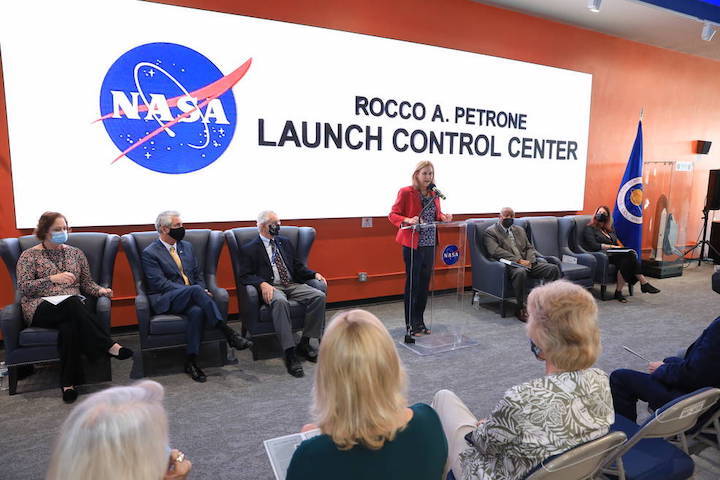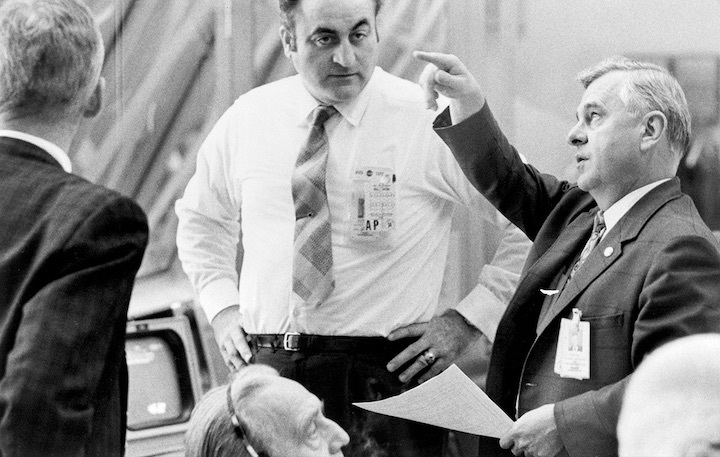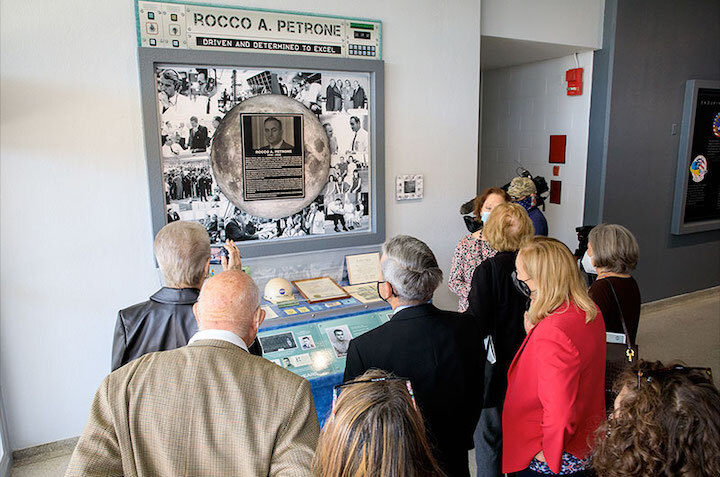24.02.2022

By Jim Cawley
NASA's Kennedy Space Center
The launch control center at NASA’s Kennedy Space Center – the same launch control that sent the first men to the Moon, launched the Space Shuttle Program, and will one day send the first woman and person of color to the lunar surface – was renamed after one of NASA’s pioneers in America’s quest for space exploration: Rocco Petrone.
Following a ceremony Feb. 22, 2022, the Launch Control Center at the Florida spaceport was officially renamed the Rocco A. Petrone Launch Control Center. Petrone, who was instrumental in America’s first voyages to the Moon and headed the Apollo program, died in 2006 at the age of 80.
Several Kennedy senior leaders attended the special event, including Center Director Janet Petro, Deputy Director Kelvin Manning, and Launch Director Charlie Blackwell-Thompson, as well as many of Petrone’s former co-workers.
“It’s fitting to name this facility for Rocco Petrone,” Petro said. “Rocco was probably the most influential architect of the Apollo Saturn program in the 1960s, and he was one of the driving forces that helped ensure Neil Armstrong walked on the Moon before the decade was out.”
The launch control center serves as a nerve center where engineers and the launch director will monitor their flight consoles and give the “go” for the upcoming launch of Artemis I and later missions that will establish a sustainable presence on the Moon to prepare for missions to Mars. It was from this same building that Petrone oversaw the launches of the early Apollo lunar missions, and later launch directors launched NASA’s shuttles into space.
“Today, we recognize the history of this building, at this great facility, by renaming it after one of NASA’s pioneers, Rocco Petrone, a man who played a pivotal role in sending the first man to the Moon and inspired generations of future engineers to challenge the status quo and to make what once seemed impossible possible,” Blackwell-Thompson said.
When Manning started exploring the possibility of the renaming project and learning more about Petrone’s influence at Kennedy, he was drawn to a baseball analogy. Specifically, Manning thought of the former Yankee Stadium, known as “The House that Ruth Built,” after the legendary Babe Ruth.
“I asked the question to a number of Kennedy retirees, ‘Was KSC the house that Rocco built?’ And the response was overwhelmingly, ‘Absolutely, yes. Without him, we would not have made it to the Moon in 1969.’”
Petrone transferred to Kennedy as an active-duty Army lieutenant colonel in 1960 to serve as Saturn Project Officer. When the United States established its goal of landing a human on the Moon by the end of the 1960s, the Apollo Lunar Landing Program was established.
He managed the planning, development and activation of all launch facilities required for the Apollo Program, including Launch Complex 39, where the Apollo and Saturn V space vehicles were launched. The complex included the Vehicle Assembly Building, the launch towers, the crawler-transporter, and the Mobile Service Structure. He was directly involved in successful launches of the Saturn I and IB – as well as the Saturn V – rockets.
Following his retirement from the Army in 1966, Petrone became director of Launch Operations at Kennedy. He was responsible for the management and technical direction of pre-flight operations and integration, test, checkout, and launch of all space vehicles, both crewed and uncrewed.
“I can’t imagine another leader who could have managed that huge, Kennedy workforce so effectively,” said John Tribe, who worked under Petrone during the Apollo and shuttle programs. “He really was the right man in the right place at the right time. He was instrumental in us successfully achieving President Kennedy’s Apollo goals.”
JoAnn Morgan, the first female engineer and first woman to serve as a senior executive at Kennedy, described Petrone as “respectful and professional, with a serious and commanding presence that permeated the environment.”
“He welcomed me,” Morgan said. “Accurate data and efficient communication of status were what mattered to him. I am very grateful to have worked for Rocco and observed the excellence in his guidance and decision making.”
Petrone directed the first five human-tended Apollo launches, culminating in the Apollo 11 lunar flight. In 1969, he was named director of the Apollo Program for NASA with overall responsibility for the direction and management of the Apollo Space Flight Program.
In 1972, he was assigned additional responsibilities as program director of the NASA portion of the U.S. and the former Soviet Union joint Apollo-Soyuz Test Program. Petrone then served as director of NASA’s Marshall Space Flight Center in Huntsville, Alabama, and as NASA associate administrator until his retirement from NASA in 1975. He worked in private industry during the 1980s and died at his home in Palos Verdes Estates, California in 2006.
“In a word, he was brilliant. Demanding, yes, but driven – and he drove us to be exactly right,” said John “Tip” Talone, a former flow director in the shuttle program. “Never was a stone left unturned or a question unanswered or sloughed off. It was obvious he was not going to let the mission, or his team, fail.”
The Florida Chapter of the NASA Alumni League endorsed the naming of the Launch Control Center in Petrone’s honor because of his strong and positive management style, his ability to problem-solve, and his personal dedication to quality work and positive outcomes, said Chapter President Richard Quinn.
“Without his strong leadership, we think the work here at Kennedy for Apollo would have been very different,” Quinn said. “There were many ‘heroes’ within NASA and our contractors during those times, but few rose to the prominence and success that Rocco did. His personal drive and commitment to excellence are legendary, and naming the Launch Control Center for him we think is a fitting tribute.”
Quelle: NASA
+++
NASA control center named for Apollo launch director Rocco Petrone
The NASA control center from where engineers oversaw the launch of the first astronauts to walk on the moon now bears the name of one of its pioneering directors.
Agency officials gathered at the Kennedy Space Center in Florida on Tuesday (Feb. 22) to honor the late Rocco Petrone, who as director of launch operations led the countdowns to the first five crewed Apollo liftoffs, culminating in the Apollo 11 moon landing in 1969. The naming of the Rocco A. Petrone Launch Control Center came as NASA prepares to resume launches to the moon under its new Artemis program.
"He dedicated himself to the challenge of planning, developing and activating the critical infrastructure that enabled the first humans to explore deep space and eventually, to land on the moon," Janet Petro, director of the Kennedy Space Center, said during Tuesday's ceremony. "Today, the same facilities that housed, transported and launched the first rockets to send humans to deep space now house and stand ready to transport and launch the vehicle that will return them and stand as a testament to the vital and essential role Mr. Petrone's contributions have made to the history of our agency."
The Launch Control Center (LCC), which was established in 1967, has been the "nerve center" from where engineers and the launch director have monitored their consoles and given the "go" for Apollo, Skylab, space shuttle, Ares and SpaceX Falcon 9 liftoffs. NASA's upcoming launch of Artemis I will use the same building and firing room that Petrone once led.
"Today, we recognize the history of this building, at this great facility, by renaming it after one of NASA's pioneers," said Charlie Blackwell-Thompson, who as Artemis I launch director is continuing Petrone's legacy. "[He] inspired generations of future engineers to challenge the status quo and to make what once seemed impossible possible."
Petrone, who died in 2006 at the age of 80, transferred to Kennedy as an active-duty Army lieutenant colonel in 1960 to serve as Saturn project officer. It was in that role, that he saw to the creation of the LCC, the adjoining Vehicle Assembly Building (VAB), the launch towers, the crawler-transporters and the Apollo Mobile Service Structure. He is credited with establishing Launch Complex 39, from where every Apollo and shuttle mission was launched, and where today SpaceX commercial flights depart for Earth orbit.
In 1966, Petrone became Kennedy Space Center's director of launch operations, giving him responsibility for the management and technical direction of pre-flight operations and the integration, test, checkout and launch of all of NASA's space vehicles, both crewed and uncrewed.
"Whenever I was around him, there was no doubt who was the boss," said John Tribe, who worked under Petrone as an engineer during the Apollo and shuttle programs. "He was rigidly disciplined [and] unbelievably well informed on technical details."
In 1969, Petrone was named director of Apollo, with overall responsibility for the direction and management of the program. He later served as director of the Marshall Space Flight Center in Alabama, and as NASA's associate administrator until his retirement from agency in 1975.
"Without his strong leadership, we think the work here at Kennedy for Apollo would have been very different," said Richard Quinn, president of the Florida Chapter of the NASA Alumni League, which endorsed the naming of the Launch Control Center in Petrone's honor. "There were many 'heroes' within NASA and our contractors during those times, but few rose to the prominence and success that Rocco did. His personal drive and commitment to excellence are legendary, and naming the Launch Control Center for him we think is a fitting tribute."
In addition to installing a large sign displaying the LCC's new name, an exhibit was added to the lobby of the building showcasing some of the items Petrone used and received during his career at NASA.
"We are so proud to have these items on display for so many to see," said Kathy Posey, Petrone's daughter, who represented her mother, Ruth, and her siblings, Terry, Nancy and Mike, at the ceremony. "I even learned some things that I didn't know about my father while looking through all the memorabilia."

Apollo program director Rocco Petrone (center) is seen in 1971 in the launch control center that would later bear his name. (NASA)

A display of memorabilia dedicated to Apollo-era launch director Rocco Petrone is viewed by guests inside the launch control center that now bears his name, on Tuesday, Feb. 22, 2022 at NASA's Kennedy Space Center in Florida. (NASA/Glenn Benson)
Quelle: CS



